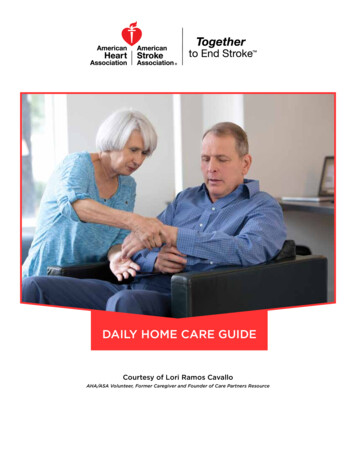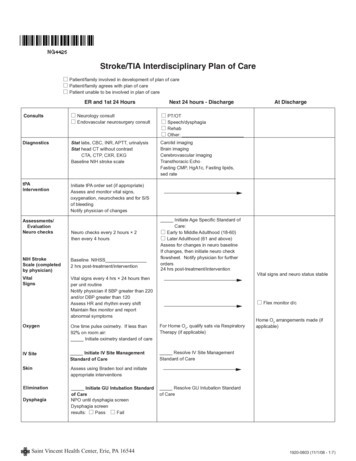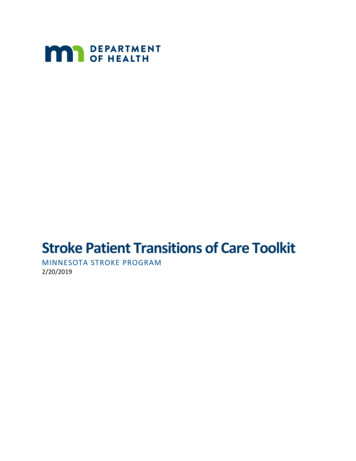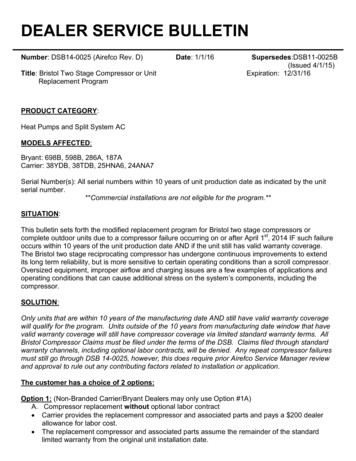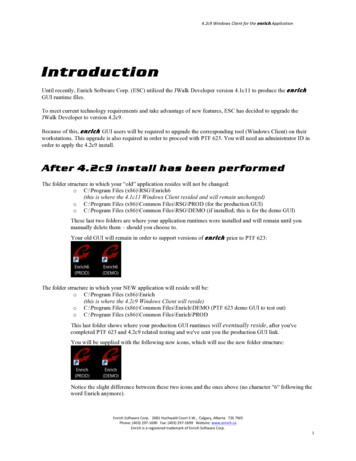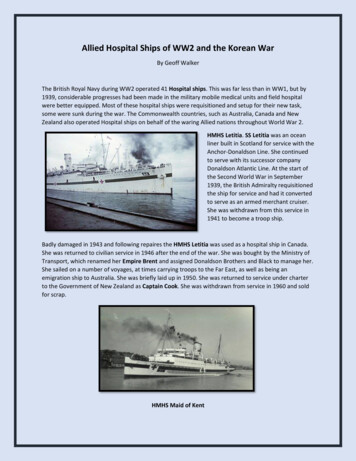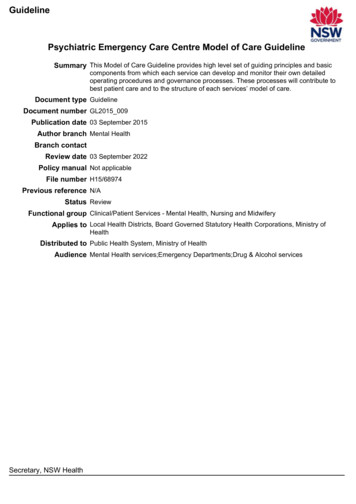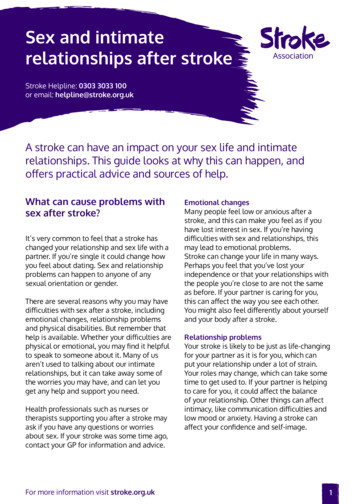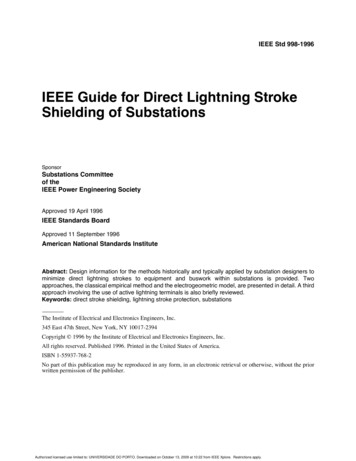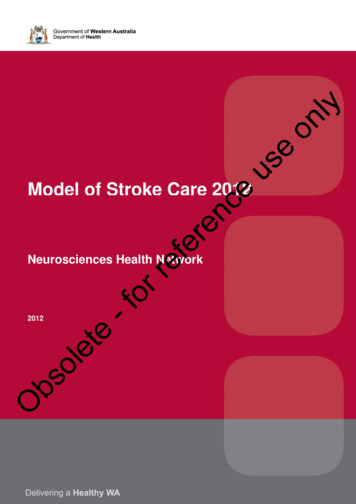
Transcription
onlyeuseferenceModel of Stroke Care 2012-forrNeurosciences Health NetworkObsolete2012
only Department of Health, State of Western Australia (2012).Suggested CitationorreferenceuseCopyright to this material produced by the Western Australian Department of Healthbelongs to the State of Western Australia, under the provisions of the Copyright Act 1968(Commonwealth Australia). Apart from any fair dealing for personal, academic, research ornon-commercial use, no part may be reproduced without written permission of the HealthNetworks Branch, Western Australian Department of Health. The Department of Health isunder no obligation to grant this permission. Please acknowledge the WA Department ofHealth when reproducing or quoting material from this source.bsolete-fDepartment of Health, Western Australia. Model of Stroke Care 2012. Perth: HealthNetworks Branch, Department of Health, Western Australia; 2012.Important Disclaimer:OAll information and content in this Material is provided in good faith by the WA Departmentof Health, and is based on sources believed to be reliable and accurate at the time ofdevelopment. The State of Western Australia, the WA Department of Health and theirrespective officers, employees and agents, do not accept legal liability or responsibility forthe Material, or any consequences arising from its use.2
Table of ContentsPART A: Executive Summary with Recommendations .6Executive summary .6onlyRecommendations.7PART B: Background & Detailed Recommendations .121.Introduction and background .12useDevelopment of the Model of Stroke Care for WA 2012 .12Guiding principles .13Objectives: .13Principles .13Expected achievements .13Developments since 2006.14Overview of stroke .14rence2.efeStroke and TIA in WA.14Definition .14Symptoms .15Diagnosis .15Treatment.15Stroke Care Pathways .173.Prevention and early intervention .19orrPrevention and early detection.19Early intervention: reducing treatment delays for stroke .21Atrial Fibrillation.225.Acute stroke care .24-f4.oletePre-hospital emergency services .24Triage and emergency department care .26Transfer of care.27Tissue Plasminogen Activator (tPA) administration .27Transient Ischaemic Attack (TIA) management .28Organisation of stroke care services .31Obs6.Stroke care across WA .31Stroke unit care.32Stroke services in rural WA.34Stroke services for Aboriginal people.357.Rehabilitation .37Stroke rehabilitation - inpatient.38Ongoing inpatient rehabilitation.388.Palliation .403
9.Discharge planning.41Discharge planning - inpatient acute and rehabilitation care.4110. Stroke rehabilitation outpatient .42Secondary prevention .4412. Long term care .46only13. Workforce .4714. Education and training .4815. Research and monitoring.49Appendices .51Achievements from Model of Stroke Care 20063 .51Stroke Epidemiology .53Evidence for treatment of stroke .57Acute Stroke Bypass Guideline 2011.60Current stroke services in WA.61Proposed Stroke Care Pathway for Rural .63Components of Early Supported Discharge .64Areas of Focus for Workforce Development .66Measuring Clinical Care.69renceuseAppendix 1:Appendix 2:Appendix 3:Appendix 4:Appendix 5:Appendix 6:Appendix 7:Appendix 8:Appendix 9:efeAcknowledgements .70Acronyms .73Obsolete-forrReference list .754
Index of tablesRisk factors associated with stroke .19Table 2:Summary of the effectiveness of drug therapies for the primaryprevention of first-ever stroke in a population of one million people.20Table 3:CHADS2 .22Table 4:Stroke risk and the CHADS2 score.22Table 5:Anticoagulation based on the CHADS2 score .23Table 6:The ABCD2 Score .29Table 7:The ABCD2 Score to Identify Patients at High Risk of Stroke Within theFirst 2 Days.29Table 8:Recommended stroke services and clinical profile .33Table 9:Summary of the effectiveness of interventions for the (secondary) preventionof recurrent stroke among 10,000 prevalent and 2,000 incident stroke andtransient ischaemic attack survivors in a population of one million people .44renceuseonlyTable 1:orrefeTable 10: Summary of the effectiveness of treating 2,000 ishaemic stroke patientseach year in a population of one million people .59Index of figuresStroke care pathway metropolitan WA .17Figure 2:Stroke care pathway rural and remote WA.18Figure 3:Recommended stroke protocols for ambulance services .25eMap of WA stroke services .32etFigure 4:-fFigure 1:Data sets available to monitor stroke clinical care .49olFigure 5:Prevalence of stroke for adults in Western Australia 2008/09 .53Figure 7:Hospitalisations for stroke and TIA .54ObsFigure 6:5
PART A: Executive Summary with RecommendationsExecutive summaryonlyStroke is a neurological condition characterised by a disrupted or ceased flow of blood tothe brain. It is a major cause of mortality and disability in Australia. In 2010, there were anestimated 60,000 new and recurrent strokes in Australia1. Although the incidence of strokeis falling with changes in community vascular risk factors and with the greater ageingpopulation, it is estimated that this number will rise to 74,000 by the year 20172. To deliverefficient, safe and high quality care to stroke survivors across the health system requiresthe development of a coordinated and integrated health service delivery model for stroke.useThe Neurosciences and the Senses Health Network, which was established as part of theWA Health reform in 2004, developed a Model of Stroke Care for Western Australia (WA)2006 (MSC2006)3.This Model was reviewed and updated in 2012 to reflect changes incurrent evidence for best practice and changes in the WA health care environment. Thisdocument reflects the principles of health reform identified by WA Health.renceThe Model of Stroke Care for WA 2012 (MSC 2012) includes increased detail andprovides a comprehensive picture of stroke services across the state. It reflects theadvances made since the MSC 20063 was first endorsed. The MSC 2012 has beenexpanded to include information on stroke services at Western Australian country hospitalsand health facilities. The revision is based on the most recent data and projections offuture service needs.-forrefeThe MSC 2012 also takes into account government policy decisions made since thepublication of the previous Model of Stroke Care for WA 20063. These include thedevelopment of a range of new Models of Care and Guidelines by Health Networks suchas Models of Care for Heart Failure4 and Acute Coronary Syndromes5 and the Protocol forAdministering Alteplase in Acute Ischaemic Stroke6. As well as the publication of the WAHealth Clinical Services Framework 2010-20207, the WA Health Strategic Intent 201020158, Revitalising WA Country Health Service 2009 - 20129, WA Sub Acute Plan 2009201310, National Stroke Foundation (NSF) Acute Services Framework 201111and the NSFClinical Guidelines for Stroke Management 201012. Consideration has also been given tothe Clinically Co-ordinated Patient Transfer Model of Service Delivery currently beingdeveloped for WA.oleteWA will continue to expand its Activity Based Funding (ABF) of health service providers,where funding is provided on the basis of activity. High quality safe health care is lessexpensive and provides better patient outcomes13. The MSC 2012 reflects the shifttowards ABF and Activity Based Management by focussing on the patient experience,improved efficiency and high quality safe care.ObsThe Neurosciences and the Senses Network recognises the need to maintain themomentum of health reform by building on existing achievements to provide ‘healthier,longer and better quality lives for all Western Australians’8. Within a constantly evolvinghealth care environment, the MSC 2012 provides an opportunity to build on successesand to identify strategies to address new challenges. Sixteen recommendations havebeen identified across the patient pathway for stroke, with specific strategies aligning toeach recommendation detailed through Part B of this document.6
Recommendations1.onlyThere are 16 recommendations arising under the MSC 2012. This section provides asummary of the recommendations with further detail on each of these areas providedunder key headings later in th
as Models of Care for Heart Failure4 and Acute Coronary Syndromes5 and the Protocol for Administering Alteplase in Acute Ischaemic Stroke6. As well as the publication of the WA Health Clinical Services Framework 2010-20207, the WA Health Strategic Intent 2010-20158, Revitalising WA Country Health Service 2009 - 20129, WA Sub Acute Plan 2009-

